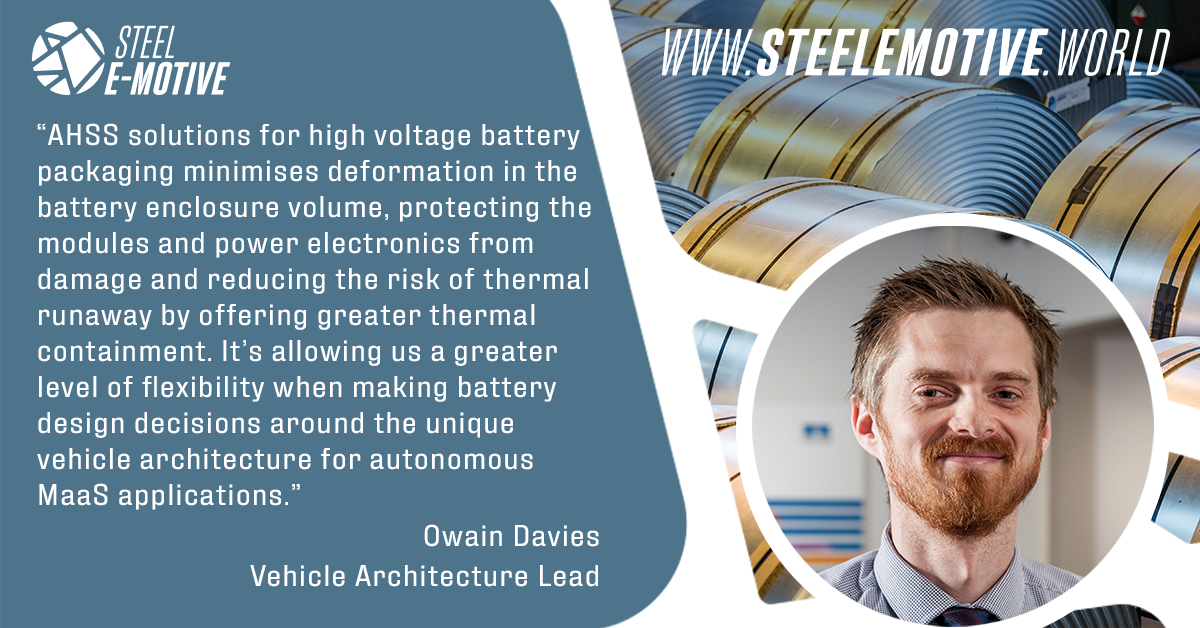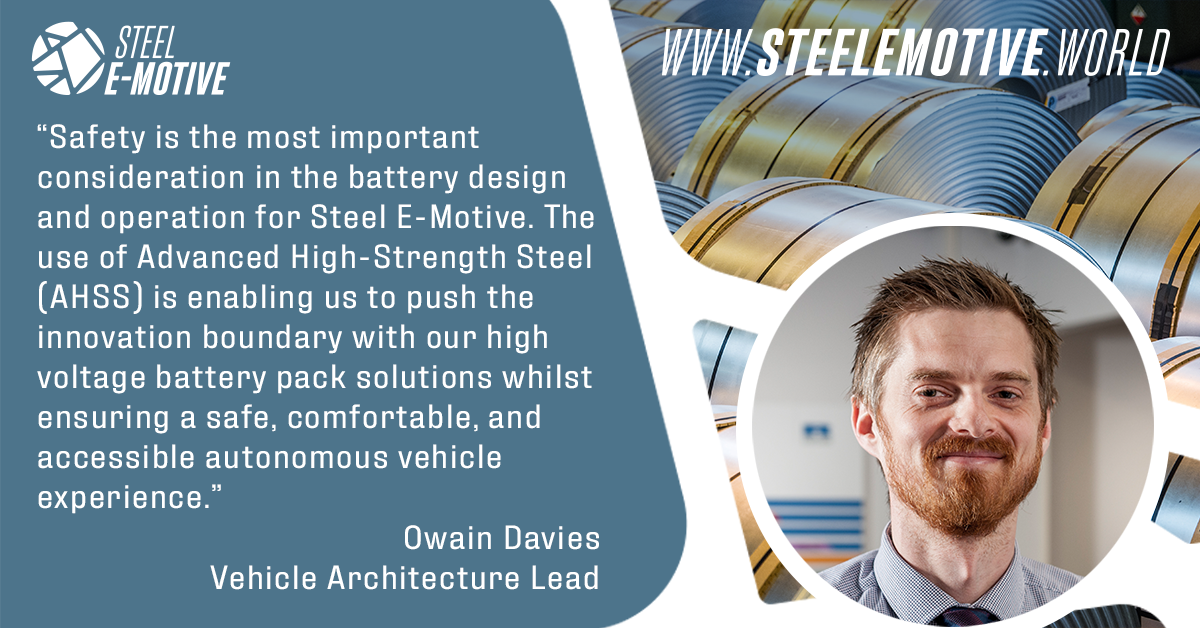BLOG STORY
Products
Product pages available in
EN - DE - FR - ES
Sustainability
News, events and stories

How AHSS is improving high voltage battery design and integration in electric vehicles for MaaS applications
A blog story by Owain Davies – Vehicle Architecture Leader, Steel E-motive project
First published on WorldAutoSteel's Steel E-Motive website - 29 June 2021
Good battery design is at the heart of any electric vehicle and can have an impact on a wide range of key stakeholder requirements. Safety, mechanical package and integration, total cost of ownership, environmental impact, durability and reliability, high energy density/capacity, acceptable range, improved charge times are all important features to consider in the design and operation of high voltage batteries.
Electric vehicles (EVs) are becoming more common on our roads, but as these vehicles become fully autonomous, will the battery design and operational requirements remain the same as conventional EVs? How does that change for vehicles designed for Mobility as a Service (MaaS) applications?
The Steel E-Motive program is creating fully autonomous electric vehicle concepts for MaaS application, targeting a 2030 launch. It is essential that the high voltage battery design and operation specifications are appropriate for the platform and will meet the expectations of the passenger, the fleet vehicle operator, and the OEMs.

The unique architecture requirements of autonomous vehicles for MaaS applications will affect battery design solutions
Future battery cell and module roadmaps for our target date of a 2030 launch highlight improvements in energy density and capacity (Wh/kg and Wh/l) which will naturally improve range and charging times. Additionally, we expect that the emphasis on mechanical package and integration that we see in conventional vehicles will remain the same.
However, because of the significant differences in vehicle architecture for autonomous vehicles for MaaS applications, there are some unique considerations that need to be reflected in the battery design. The Steel E-Motive vehicle concepts are being designed with accessibility in mind and will have a flat floor and step-in access with consideration given to how the doors assist occupant ingress/egress.
Due to the nature of the open flat floor cabin area within the body in white, battery local to global vehicle bending performance will be emphasised. Step-in height for occupant ingress is being considered along with the maximisation of space for suitable longitudinals and/or cross members. The power distribution unit also must be compatible with a flat floor as traditionally you would find these in the seat pan area, the tunnel, or the IP area – all of which have been removed from the vehicle concept.
Additional vertical ‘walk in’ load, which is not seen on a conventional sedan, also is required. The impact that closures can have on rockers and packs must also be minimised.
Cost, maintenance, and downtime are big factors for fleet operators
In addition to the impact that the unique vehicle architecture of the Steel E-Motive vehicles will have on the design of the battery, we also must focus on cost and uptime. Fleet operators put a greater emphasis on total cost of ownership and are aiming for high vehicle usage. Maintaining battery health is critical to reducing downtime, as will fast-charge capacity. Potentially a move to wireless on-the-move charging might be considered in the future.
High voltage batteries are developed to several safety standards which ensure safety risks are reduced. Even in conventional electric vehicles, if batteries are ruptured, for example in a high-speed collision, then this can lead to fires and the release of toxic gases. It is for this reason that all electric vehicles are developed to meet Euro NCAP safety standards for front, side, and rear collision events, and that legislation and standards exist to ensure the safe transportation and handling of battery packs.
Battery Safety Requirements for the Steel E-Motive Vehicles
Here are some of the legislative, market, battery and vehicle specific examples of the safety requirements considered for the Steel E-Motive vehicles:
- Underfloor Protection - Abuse criteria such as debris and dynamic impact considering piercing and rupture
- Thermal runaway (containment)
- Sealing, e.g. pack perimeter and venting
- Durability
- Crashworthiness - Front (inc. central pole), Rear and Side Crash
- Crush performance at pack level
Advanced High-Strength Steel solutions are key to developing a safe autonomous vehicle experience
Safety is the most important consideration in the battery design and operation for Steel E-Motive. The use of Advanced High-Strength Steel (AHSS) is enabling us to push the innovation boundary with our high voltage battery pack solutions whilst ensuring a safe, comfortable, and accessible autonomous vehicle experience.
For example, AHSS solutions for high voltage battery packaging minimise deformation in the battery enclosure volume, protecting the modules and power electronics from damage and reducing the risk of thermal runaway by offering greater thermal containment.
Additionally, AHSS use is allowing us a greater level of flexibility when making battery design decisions around the unique vehicle architecture for autonomous MaaS applications by offering us:
- Mass and cost reductions from pack to the body in white making a positive impact on LCA
- Numerous options for pack architecture and integration
- Reduced build takt times for pack assembly from cell to vehicle
- Service/low maintenance for reduced downtime







